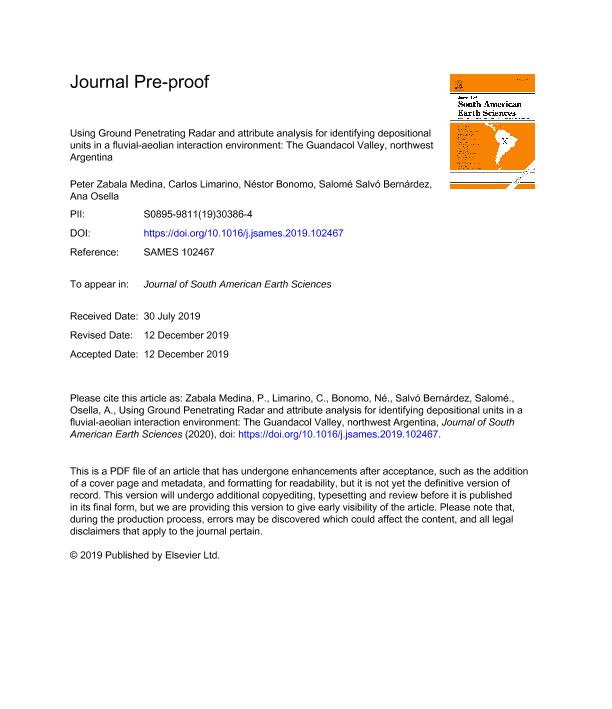Artículo
Using Ground Penetrating Radar and attribute analysis for identifying depositional units in a fluvial-aeolian interaction environment: The Guandacol Valley, northwest Argentina
Zabala Medina, Peter ; Limarino, Carlos Oscar
; Limarino, Carlos Oscar ; Bonomo, Nestor Eduardo
; Bonomo, Nestor Eduardo ; Salvó Bernárdez, Salomé Candela
; Salvó Bernárdez, Salomé Candela ; Osella, Ana Maria
; Osella, Ana Maria
 ; Limarino, Carlos Oscar
; Limarino, Carlos Oscar ; Bonomo, Nestor Eduardo
; Bonomo, Nestor Eduardo ; Salvó Bernárdez, Salomé Candela
; Salvó Bernárdez, Salomé Candela ; Osella, Ana Maria
; Osella, Ana Maria
Fecha de publicación:
03/2020
Editorial:
Pergamon-Elsevier Science Ltd
Revista:
Journal of South American Earth Sciences
ISSN:
0895-9811
Idioma:
Inglés
Tipo de recurso:
Artículo publicado
Clasificación temática:
Resumen
This paper deals with the application of the Ground Penetrating Radar (GPR) method and the analysis of attributes of the GPR data to characterize and interpret a fluvial-aeolian interaction field located in the Guandacol Valley, northwest Argentina. Several profiles over dunes, interdunes, aeolian mesoforms, and fluvial channels have been acquired. Each data section is analyzed by using standard images of the amplitude of the electric field, as well as representations of different attributes of the reflections such as contrast, dip, curvature, parallelism, and RMS frequency. The analysis of attributes improves the interpretation of the subsurface, by quantifying and making evident properties of the reflection patterns that characterize the sedimentary units. The information obtained using the GPR profiles allows defining seven radar packages, which are useful for reconstructing the internal structure of the fluvial-aeolian succession. Packages 1, 2 and 3 illustrate the stratification of different types of low-sinuosity and high-sinuosity aeolian dunes, as well as aeolian mesoforms. Package 4 corresponds to horizontal or low-angle inclined reflectors obtained in both sandy interdunes and upper parts of several aeolian dunes. A muddy bed that covers most of the area (package 5) probably indicates a period of climate amelioration linked to a high level of the water table. The fluvial component of the fluvial-aeolian succession exhibits two different packages; package 6 represents the infill of partially incised fluvial channels with frequent incisions (concave-up bounding surfaces) and bars (convex-up surfaces). Package 7 is composed of the stacking of parallel to subparallel horizontal reflectors, without concave-up surfaces that indicate deep channels. Finally, we propose a conceptual model that relates the principal radar packages with the temporal evolution of the fluvial-aeolian interaction field of Guandacol Valley.
Archivos asociados
Licencia
Identificadores
Colecciones
Articulos(IFIBA)
Articulos de INST.DE FISICA DE BUENOS AIRES
Articulos de INST.DE FISICA DE BUENOS AIRES
Articulos(IGEBA)
Articulos de INSTITUTO DE GEOCIENCIAS BASICAS, APLICADAS Y AMBIENTALES DE BS. AS
Articulos de INSTITUTO DE GEOCIENCIAS BASICAS, APLICADAS Y AMBIENTALES DE BS. AS
Citación
Zabala Medina, Peter; Limarino, Carlos Oscar; Bonomo, Nestor Eduardo; Salvó Bernárdez, Salomé Candela; Osella, Ana Maria; Using Ground Penetrating Radar and attribute analysis for identifying depositional units in a fluvial-aeolian interaction environment: The Guandacol Valley, northwest Argentina; Pergamon-Elsevier Science Ltd; Journal of South American Earth Sciences; 98; 102467; 3-2020; 1-16
Compartir
Altmétricas



